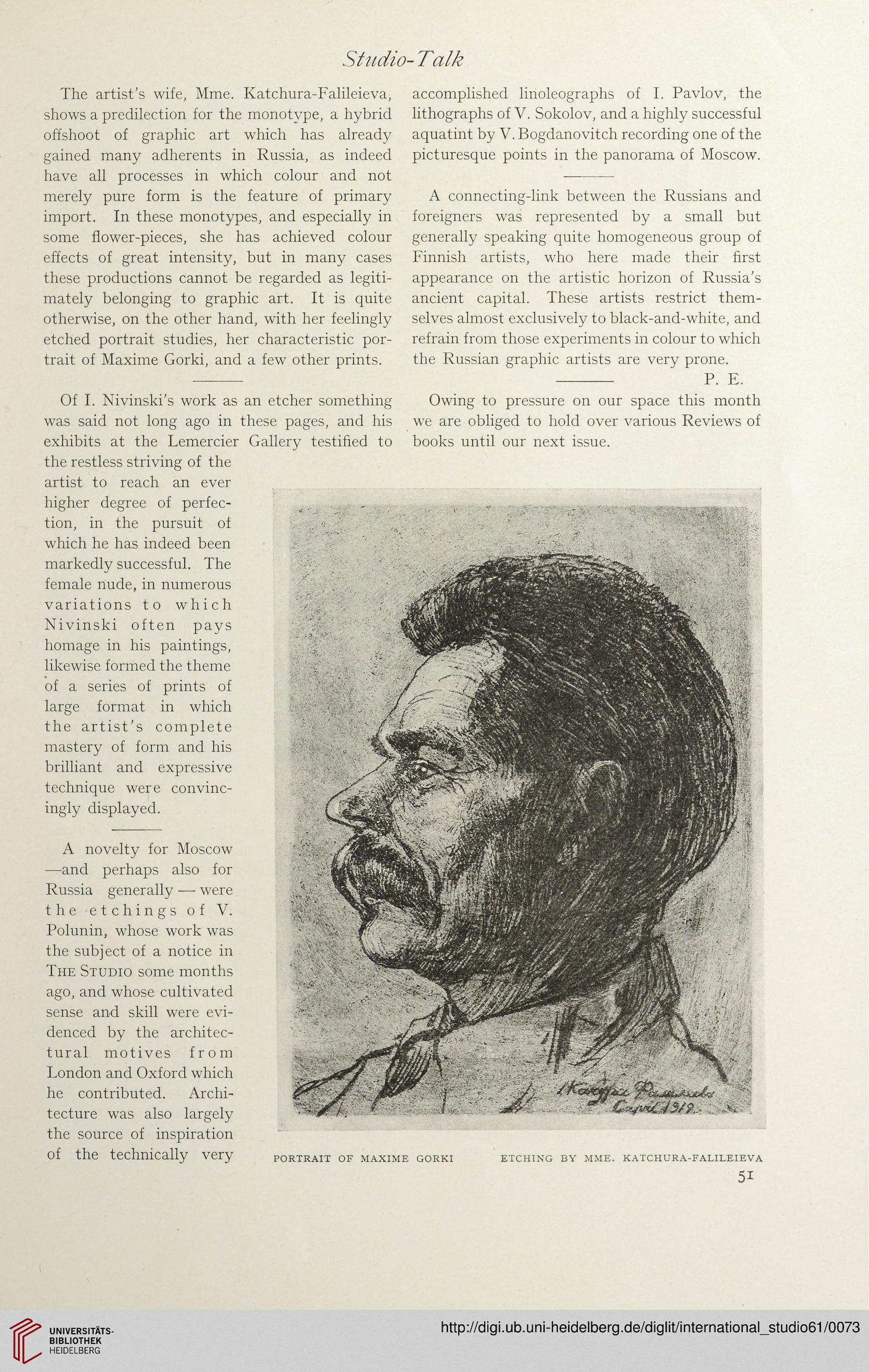Studio-Talk
The artist’s wife, Mme. Katchura-Falileieva,
shows a predilection for the monotype, a hybrid
offshoot of graphic art which has already
gained many adherents in Russia, as indeed
have all processes in which colour and not
merely pure form is the feature of primary
import. In these monotypes, and especially in
some flower-pieces, she has achieved colour
effects of great intensity, but in many cases
these productions cannot be regarded as legiti-
mately belonging to graphic art. It is quite
otherwise, on the other hand, with her feelingly
etched portrait studies, her characteristic por-
trait of Maxime Gorki, and a few other prints.
Of I. Nivinski’s work as an etcher something
was said not long ago in these pages, and his
exhibits at the Lemercier Gallery testified to
the restless striving of the
artist to reach an ever
accomplished linoleographs of I. Pavlov, the
lithographs of V. Sokolov, and a highly successful
aquatint by V. Bogdanovitch recording one of the
picturesque points in the panorama of Moscow.
A connecting-link between the Russians and
foreigners was represented by a small but
generally speaking quite homogeneous group of
Finnish artists, who here made their first
appearance on the artistic horizon of Russia’s
ancient capital. These artists restrict them-
selves almost exclusively to black-and-white, and
refrain from those experiments in colour to which
the Russian graphic artists are very prone.
- P. E.
Owing to pressure on our space this month
we are obliged to hold over various Reviews of
books until our next issue.
higher degree of perfec-
tion, in the pursuit of
which he has indeed been
markedly successful. The
female nude, in numerous
variations to which
Nivinski often pays
homage in his paintings,
likewise formed the theme
of a series of prints of
large format in which
the artist’s complete
mastery of form and his
brilliant and expressive
technique were convinc-
ingly displayed.
A novelty for Moscow
-—and perhaps also for
Russia generally —- were
the etchings of V.
Polunin, whose work was
the subject of a notice in
The Studio some months
ago, and whose cultivated
sense and skill were evi-
denced by the architec-
tural motives from
London and Oxford which
he contributed. Archi-
tecture was also largely
the source of inspiration
of the technically very
PORTRAIT OF MAXIME GORKI
ETCHING BY MME. KATCHURA-FALILEIEVA
51
The artist’s wife, Mme. Katchura-Falileieva,
shows a predilection for the monotype, a hybrid
offshoot of graphic art which has already
gained many adherents in Russia, as indeed
have all processes in which colour and not
merely pure form is the feature of primary
import. In these monotypes, and especially in
some flower-pieces, she has achieved colour
effects of great intensity, but in many cases
these productions cannot be regarded as legiti-
mately belonging to graphic art. It is quite
otherwise, on the other hand, with her feelingly
etched portrait studies, her characteristic por-
trait of Maxime Gorki, and a few other prints.
Of I. Nivinski’s work as an etcher something
was said not long ago in these pages, and his
exhibits at the Lemercier Gallery testified to
the restless striving of the
artist to reach an ever
accomplished linoleographs of I. Pavlov, the
lithographs of V. Sokolov, and a highly successful
aquatint by V. Bogdanovitch recording one of the
picturesque points in the panorama of Moscow.
A connecting-link between the Russians and
foreigners was represented by a small but
generally speaking quite homogeneous group of
Finnish artists, who here made their first
appearance on the artistic horizon of Russia’s
ancient capital. These artists restrict them-
selves almost exclusively to black-and-white, and
refrain from those experiments in colour to which
the Russian graphic artists are very prone.
- P. E.
Owing to pressure on our space this month
we are obliged to hold over various Reviews of
books until our next issue.
higher degree of perfec-
tion, in the pursuit of
which he has indeed been
markedly successful. The
female nude, in numerous
variations to which
Nivinski often pays
homage in his paintings,
likewise formed the theme
of a series of prints of
large format in which
the artist’s complete
mastery of form and his
brilliant and expressive
technique were convinc-
ingly displayed.
A novelty for Moscow
-—and perhaps also for
Russia generally —- were
the etchings of V.
Polunin, whose work was
the subject of a notice in
The Studio some months
ago, and whose cultivated
sense and skill were evi-
denced by the architec-
tural motives from
London and Oxford which
he contributed. Archi-
tecture was also largely
the source of inspiration
of the technically very
PORTRAIT OF MAXIME GORKI
ETCHING BY MME. KATCHURA-FALILEIEVA
51




